Social Work Assignment: Child Abuse and Neglect Implications
VerifiedAdded on 2019/09/25
|5
|1938
|161
Homework Assignment
AI Summary
This homework assignment delves into various aspects of child protection and social work practice. It begins by examining the implications of child protection workers' views on mothering and how to reduce 'mother blaming' in decision-making. The assignment then analyzes vulnerability factors in child abuse and neglect cases, drawing from a provided case study. It explores the importance of culturally sensitive practice for social workers in Australia, defining the concept and providing reasons for its necessity. Furthermore, the assignment summarizes and critically analyzes key findings on communication skills between social workers and families in child abuse and neglect cases, offering recommendations for improvement. Finally, it prompts a reflection on the role of a social worker, considering key concerns and questions to gather information in a specific case involving potential neglect, using literature on children’s experiences of neglect to support the analysis. The assignment emphasizes the importance of effective communication, cultural sensitivity, and a nuanced understanding of family dynamics in child protection work.
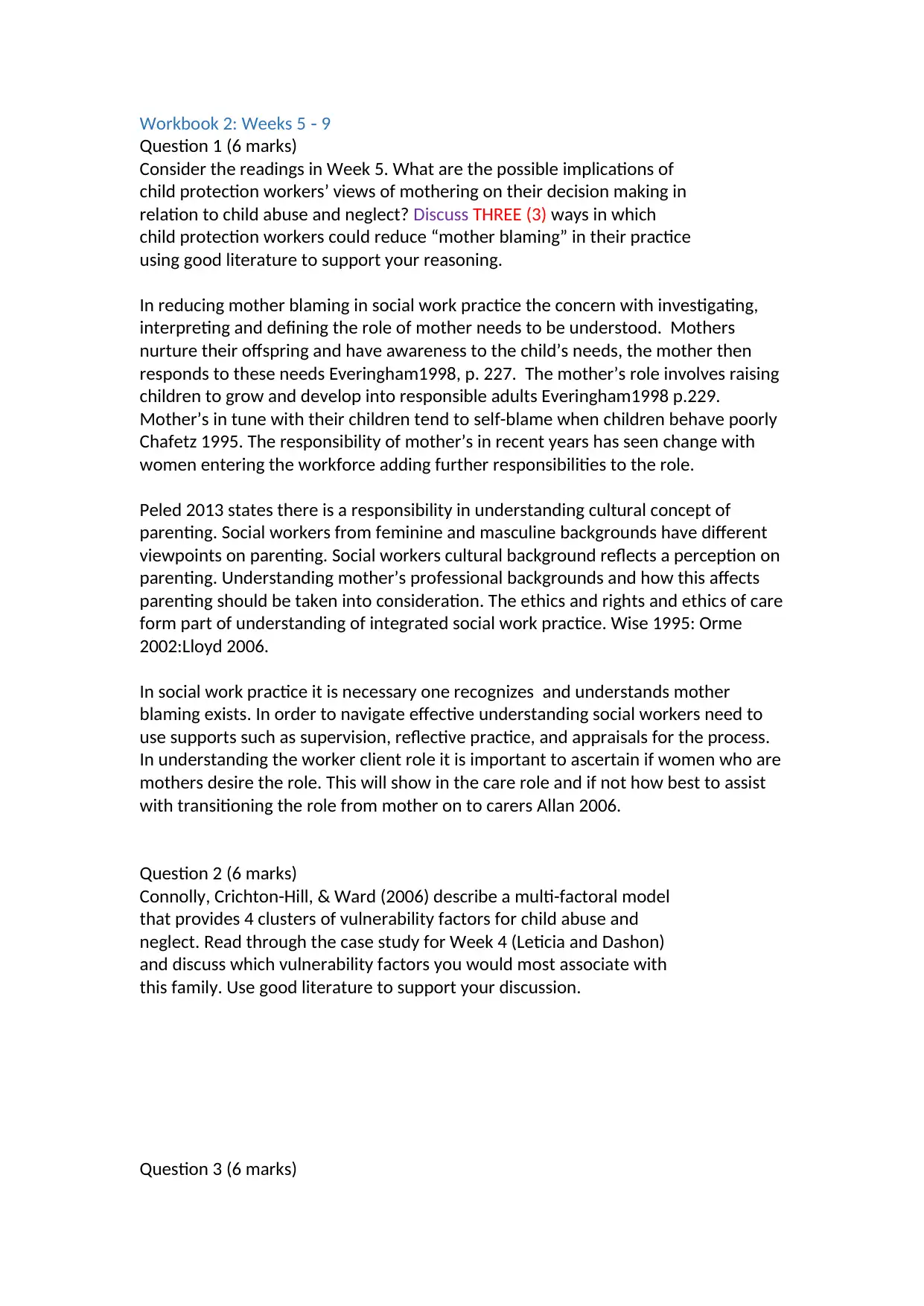
Workbook 2: Weeks 5 ‐ 9
Question 1 (6 marks)
Consider the readings in Week 5. What are the possible implications of
child protection workers’ views of mothering on their decision making in
relation to child abuse and neglect? Discuss THREE (3) ways in which
child protection workers could reduce “mother blaming” in their practice
using good literature to support your reasoning.
In reducing mother blaming in social work practice the concern with investigating,
interpreting and defining the role of mother needs to be understood. Mothers
nurture their offspring and have awareness to the child’s needs, the mother then
responds to these needs Everingham1998, p. 227. The mother’s role involves raising
children to grow and develop into responsible adults Everingham1998 p.229.
Mother’s in tune with their children tend to self-blame when children behave poorly
Chafetz 1995. The responsibility of mother’s in recent years has seen change with
women entering the workforce adding further responsibilities to the role.
Peled 2013 states there is a responsibility in understanding cultural concept of
parenting. Social workers from feminine and masculine backgrounds have different
viewpoints on parenting. Social workers cultural background reflects a perception on
parenting. Understanding mother’s professional backgrounds and how this affects
parenting should be taken into consideration. The ethics and rights and ethics of care
form part of understanding of integrated social work practice. Wise 1995: Orme
2002:Lloyd 2006.
In social work practice it is necessary one recognizes and understands mother
blaming exists. In order to navigate effective understanding social workers need to
use supports such as supervision, reflective practice, and appraisals for the process.
In understanding the worker client role it is important to ascertain if women who are
mothers desire the role. This will show in the care role and if not how best to assist
with transitioning the role from mother on to carers Allan 2006.
Question 2 (6 marks)
Connolly, Crichton-Hill, & Ward (2006) describe a multi-factoral model
that provides 4 clusters of vulnerability factors for child abuse and
neglect. Read through the case study for Week 4 (Leticia and Dashon)
and discuss which vulnerability factors you would most associate with
this family. Use good literature to support your discussion.
Question 3 (6 marks)
Question 1 (6 marks)
Consider the readings in Week 5. What are the possible implications of
child protection workers’ views of mothering on their decision making in
relation to child abuse and neglect? Discuss THREE (3) ways in which
child protection workers could reduce “mother blaming” in their practice
using good literature to support your reasoning.
In reducing mother blaming in social work practice the concern with investigating,
interpreting and defining the role of mother needs to be understood. Mothers
nurture their offspring and have awareness to the child’s needs, the mother then
responds to these needs Everingham1998, p. 227. The mother’s role involves raising
children to grow and develop into responsible adults Everingham1998 p.229.
Mother’s in tune with their children tend to self-blame when children behave poorly
Chafetz 1995. The responsibility of mother’s in recent years has seen change with
women entering the workforce adding further responsibilities to the role.
Peled 2013 states there is a responsibility in understanding cultural concept of
parenting. Social workers from feminine and masculine backgrounds have different
viewpoints on parenting. Social workers cultural background reflects a perception on
parenting. Understanding mother’s professional backgrounds and how this affects
parenting should be taken into consideration. The ethics and rights and ethics of care
form part of understanding of integrated social work practice. Wise 1995: Orme
2002:Lloyd 2006.
In social work practice it is necessary one recognizes and understands mother
blaming exists. In order to navigate effective understanding social workers need to
use supports such as supervision, reflective practice, and appraisals for the process.
In understanding the worker client role it is important to ascertain if women who are
mothers desire the role. This will show in the care role and if not how best to assist
with transitioning the role from mother on to carers Allan 2006.
Question 2 (6 marks)
Connolly, Crichton-Hill, & Ward (2006) describe a multi-factoral model
that provides 4 clusters of vulnerability factors for child abuse and
neglect. Read through the case study for Week 4 (Leticia and Dashon)
and discuss which vulnerability factors you would most associate with
this family. Use good literature to support your discussion.
Question 3 (6 marks)
Paraphrase This Document
Need a fresh take? Get an instant paraphrase of this document with our AI Paraphraser
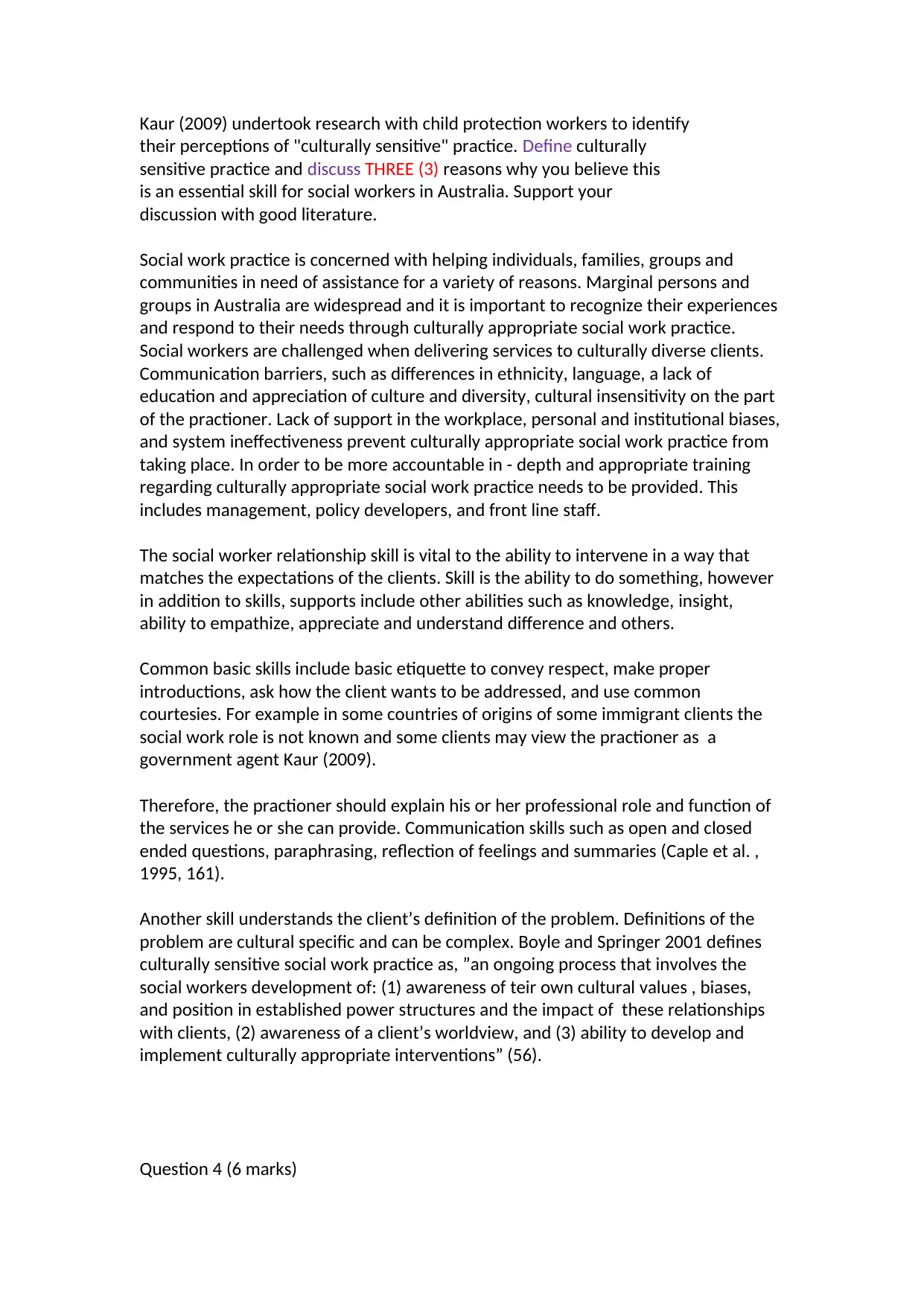
Kaur (2009) undertook research with child protection workers to identify
their perceptions of "culturally sensitive" practice. Define culturally
sensitive practice and discuss THREE (3) reasons why you believe this
is an essential skill for social workers in Australia. Support your
discussion with good literature.
Social work practice is concerned with helping individuals, families, groups and
communities in need of assistance for a variety of reasons. Marginal persons and
groups in Australia are widespread and it is important to recognize their experiences
and respond to their needs through culturally appropriate social work practice.
Social workers are challenged when delivering services to culturally diverse clients.
Communication barriers, such as differences in ethnicity, language, a lack of
education and appreciation of culture and diversity, cultural insensitivity on the part
of the practioner. Lack of support in the workplace, personal and institutional biases,
and system ineffectiveness prevent culturally appropriate social work practice from
taking place. In order to be more accountable in - depth and appropriate training
regarding culturally appropriate social work practice needs to be provided. This
includes management, policy developers, and front line staff.
The social worker relationship skill is vital to the ability to intervene in a way that
matches the expectations of the clients. Skill is the ability to do something, however
in addition to skills, supports include other abilities such as knowledge, insight,
ability to empathize, appreciate and understand difference and others.
Common basic skills include basic etiquette to convey respect, make proper
introductions, ask how the client wants to be addressed, and use common
courtesies. For example in some countries of origins of some immigrant clients the
social work role is not known and some clients may view the practioner as a
government agent Kaur (2009).
Therefore, the practioner should explain his or her professional role and function of
the services he or she can provide. Communication skills such as open and closed
ended questions, paraphrasing, reflection of feelings and summaries (Caple et al. ,
1995, 161).
Another skill understands the client’s definition of the problem. Definitions of the
problem are cultural specific and can be complex. Boyle and Springer 2001 defines
culturally sensitive social work practice as, ”an ongoing process that involves the
social workers development of: (1) awareness of teir own cultural values , biases,
and position in established power structures and the impact of these relationships
with clients, (2) awareness of a client’s worldview, and (3) ability to develop and
implement culturally appropriate interventions” (56).
Question 4 (6 marks)
their perceptions of "culturally sensitive" practice. Define culturally
sensitive practice and discuss THREE (3) reasons why you believe this
is an essential skill for social workers in Australia. Support your
discussion with good literature.
Social work practice is concerned with helping individuals, families, groups and
communities in need of assistance for a variety of reasons. Marginal persons and
groups in Australia are widespread and it is important to recognize their experiences
and respond to their needs through culturally appropriate social work practice.
Social workers are challenged when delivering services to culturally diverse clients.
Communication barriers, such as differences in ethnicity, language, a lack of
education and appreciation of culture and diversity, cultural insensitivity on the part
of the practioner. Lack of support in the workplace, personal and institutional biases,
and system ineffectiveness prevent culturally appropriate social work practice from
taking place. In order to be more accountable in - depth and appropriate training
regarding culturally appropriate social work practice needs to be provided. This
includes management, policy developers, and front line staff.
The social worker relationship skill is vital to the ability to intervene in a way that
matches the expectations of the clients. Skill is the ability to do something, however
in addition to skills, supports include other abilities such as knowledge, insight,
ability to empathize, appreciate and understand difference and others.
Common basic skills include basic etiquette to convey respect, make proper
introductions, ask how the client wants to be addressed, and use common
courtesies. For example in some countries of origins of some immigrant clients the
social work role is not known and some clients may view the practioner as a
government agent Kaur (2009).
Therefore, the practioner should explain his or her professional role and function of
the services he or she can provide. Communication skills such as open and closed
ended questions, paraphrasing, reflection of feelings and summaries (Caple et al. ,
1995, 161).
Another skill understands the client’s definition of the problem. Definitions of the
problem are cultural specific and can be complex. Boyle and Springer 2001 defines
culturally sensitive social work practice as, ”an ongoing process that involves the
social workers development of: (1) awareness of teir own cultural values , biases,
and position in established power structures and the impact of these relationships
with clients, (2) awareness of a client’s worldview, and (3) ability to develop and
implement culturally appropriate interventions” (56).
Question 4 (6 marks)
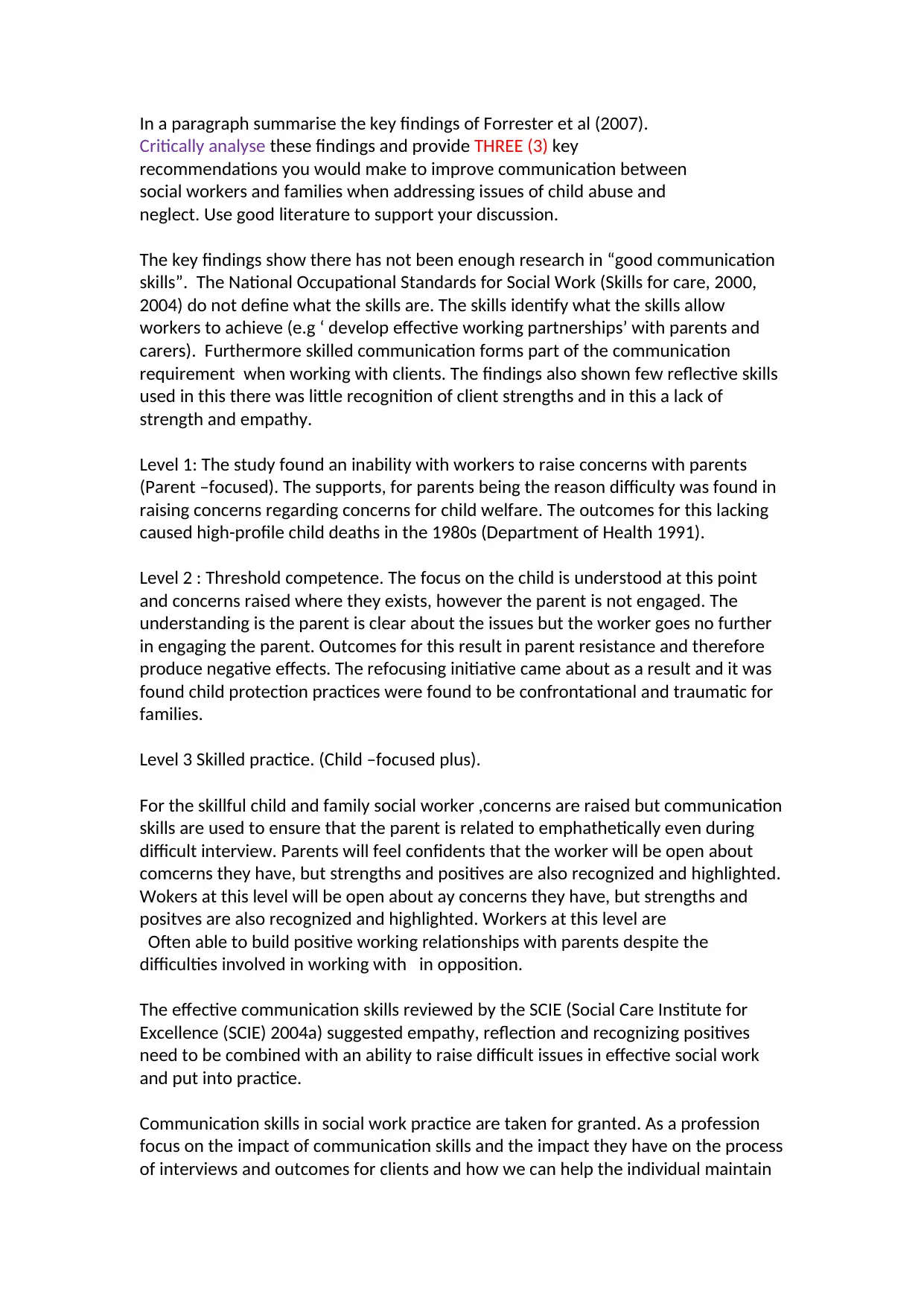
In a paragraph summarise the key findings of Forrester et al (2007).
Critically analyse these findings and provide THREE (3) key
recommendations you would make to improve communication between
social workers and families when addressing issues of child abuse and
neglect. Use good literature to support your discussion.
The key findings show there has not been enough research in “good communication
skills”. The National Occupational Standards for Social Work (Skills for care, 2000,
2004) do not define what the skills are. The skills identify what the skills allow
workers to achieve (e.g ‘ develop effective working partnerships’ with parents and
carers). Furthermore skilled communication forms part of the communication
requirement when working with clients. The findings also shown few reflective skills
used in this there was little recognition of client strengths and in this a lack of
strength and empathy.
Level 1: The study found an inability with workers to raise concerns with parents
(Parent –focused). The supports, for parents being the reason difficulty was found in
raising concerns regarding concerns for child welfare. The outcomes for this lacking
caused high-profile child deaths in the 1980s (Department of Health 1991).
Level 2 : Threshold competence. The focus on the child is understood at this point
and concerns raised where they exists, however the parent is not engaged. The
understanding is the parent is clear about the issues but the worker goes no further
in engaging the parent. Outcomes for this result in parent resistance and therefore
produce negative effects. The refocusing initiative came about as a result and it was
found child protection practices were found to be confrontational and traumatic for
families.
Level 3 Skilled practice. (Child –focused plus).
For the skillful child and family social worker ,concerns are raised but communication
skills are used to ensure that the parent is related to emphathetically even during
difficult interview. Parents will feel confidents that the worker will be open about
comcerns they have, but strengths and positives are also recognized and highlighted.
Wokers at this level will be open about ay concerns they have, but strengths and
positves are also recognized and highlighted. Workers at this level are
Often able to build positive working relationships with parents despite the
difficulties involved in working with in opposition.
The effective communication skills reviewed by the SCIE (Social Care Institute for
Excellence (SCIE) 2004a) suggested empathy, reflection and recognizing positives
need to be combined with an ability to raise difficult issues in effective social work
and put into practice.
Communication skills in social work practice are taken for granted. As a profession
focus on the impact of communication skills and the impact they have on the process
of interviews and outcomes for clients and how we can help the individual maintain
Critically analyse these findings and provide THREE (3) key
recommendations you would make to improve communication between
social workers and families when addressing issues of child abuse and
neglect. Use good literature to support your discussion.
The key findings show there has not been enough research in “good communication
skills”. The National Occupational Standards for Social Work (Skills for care, 2000,
2004) do not define what the skills are. The skills identify what the skills allow
workers to achieve (e.g ‘ develop effective working partnerships’ with parents and
carers). Furthermore skilled communication forms part of the communication
requirement when working with clients. The findings also shown few reflective skills
used in this there was little recognition of client strengths and in this a lack of
strength and empathy.
Level 1: The study found an inability with workers to raise concerns with parents
(Parent –focused). The supports, for parents being the reason difficulty was found in
raising concerns regarding concerns for child welfare. The outcomes for this lacking
caused high-profile child deaths in the 1980s (Department of Health 1991).
Level 2 : Threshold competence. The focus on the child is understood at this point
and concerns raised where they exists, however the parent is not engaged. The
understanding is the parent is clear about the issues but the worker goes no further
in engaging the parent. Outcomes for this result in parent resistance and therefore
produce negative effects. The refocusing initiative came about as a result and it was
found child protection practices were found to be confrontational and traumatic for
families.
Level 3 Skilled practice. (Child –focused plus).
For the skillful child and family social worker ,concerns are raised but communication
skills are used to ensure that the parent is related to emphathetically even during
difficult interview. Parents will feel confidents that the worker will be open about
comcerns they have, but strengths and positives are also recognized and highlighted.
Wokers at this level will be open about ay concerns they have, but strengths and
positves are also recognized and highlighted. Workers at this level are
Often able to build positive working relationships with parents despite the
difficulties involved in working with in opposition.
The effective communication skills reviewed by the SCIE (Social Care Institute for
Excellence (SCIE) 2004a) suggested empathy, reflection and recognizing positives
need to be combined with an ability to raise difficult issues in effective social work
and put into practice.
Communication skills in social work practice are taken for granted. As a profession
focus on the impact of communication skills and the impact they have on the process
of interviews and outcomes for clients and how we can help the individual maintain
⊘ This is a preview!⊘
Do you want full access?
Subscribe today to unlock all pages.

Trusted by 1+ million students worldwide
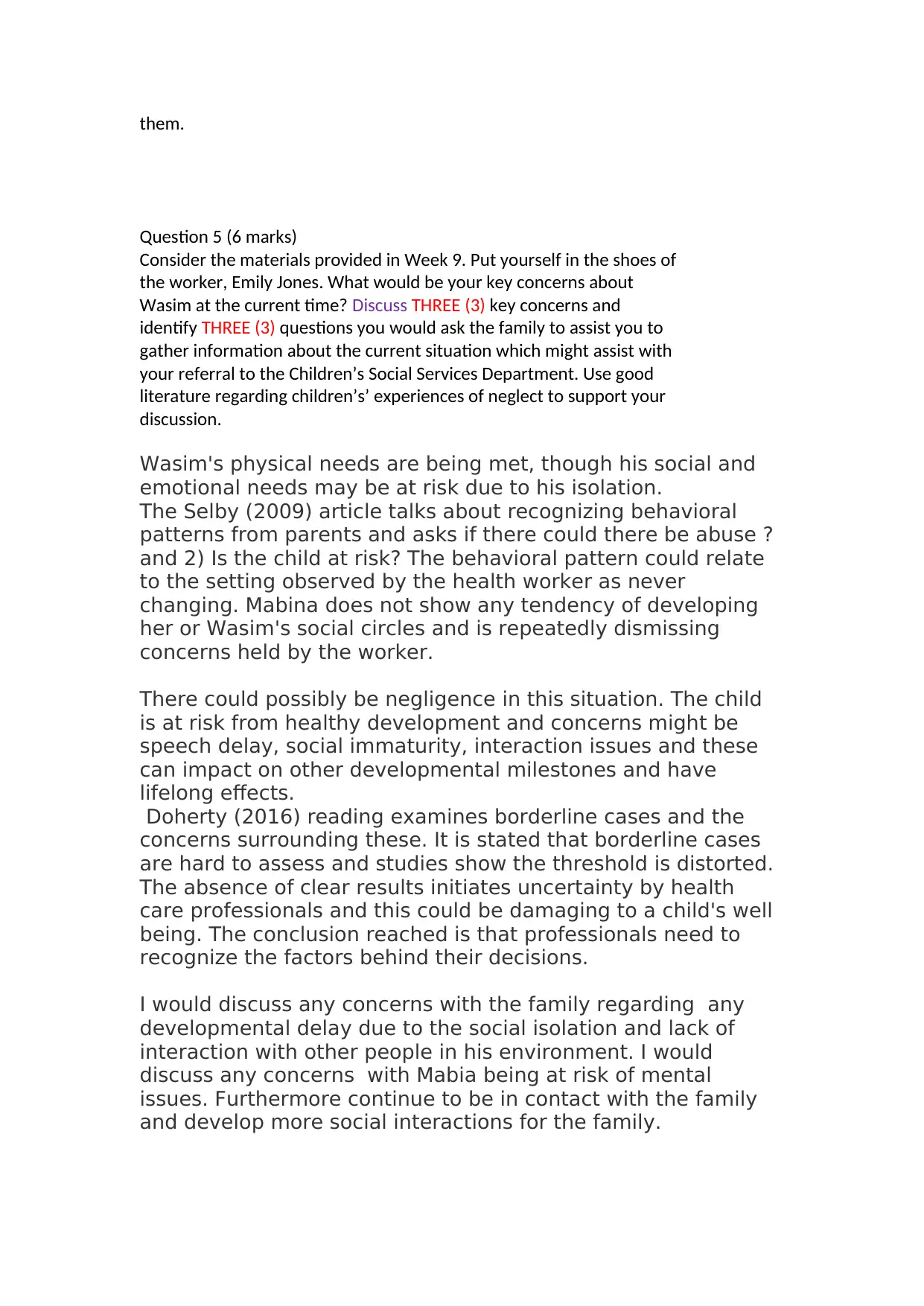
them.
Question 5 (6 marks)
Consider the materials provided in Week 9. Put yourself in the shoes of
the worker, Emily Jones. What would be your key concerns about
Wasim at the current time? Discuss THREE (3) key concerns and
identify THREE (3) questions you would ask the family to assist you to
gather information about the current situation which might assist with
your referral to the Children’s Social Services Department. Use good
literature regarding children’s’ experiences of neglect to support your
discussion.
Wasim's physical needs are being met, though his social and
emotional needs may be at risk due to his isolation.
The Selby (2009) article talks about recognizing behavioral
patterns from parents and asks if there could there be abuse ?
and 2) Is the child at risk? The behavioral pattern could relate
to the setting observed by the health worker as never
changing. Mabina does not show any tendency of developing
her or Wasim's social circles and is repeatedly dismissing
concerns held by the worker.
There could possibly be negligence in this situation. The child
is at risk from healthy development and concerns might be
speech delay, social immaturity, interaction issues and these
can impact on other developmental milestones and have
lifelong effects.
Doherty (2016) reading examines borderline cases and the
concerns surrounding these. It is stated that borderline cases
are hard to assess and studies show the threshold is distorted.
The absence of clear results initiates uncertainty by health
care professionals and this could be damaging to a child's well
being. The conclusion reached is that professionals need to
recognize the factors behind their decisions.
I would discuss any concerns with the family regarding any
developmental delay due to the social isolation and lack of
interaction with other people in his environment. I would
discuss any concerns with Mabia being at risk of mental
issues. Furthermore continue to be in contact with the family
and develop more social interactions for the family.
Question 5 (6 marks)
Consider the materials provided in Week 9. Put yourself in the shoes of
the worker, Emily Jones. What would be your key concerns about
Wasim at the current time? Discuss THREE (3) key concerns and
identify THREE (3) questions you would ask the family to assist you to
gather information about the current situation which might assist with
your referral to the Children’s Social Services Department. Use good
literature regarding children’s’ experiences of neglect to support your
discussion.
Wasim's physical needs are being met, though his social and
emotional needs may be at risk due to his isolation.
The Selby (2009) article talks about recognizing behavioral
patterns from parents and asks if there could there be abuse ?
and 2) Is the child at risk? The behavioral pattern could relate
to the setting observed by the health worker as never
changing. Mabina does not show any tendency of developing
her or Wasim's social circles and is repeatedly dismissing
concerns held by the worker.
There could possibly be negligence in this situation. The child
is at risk from healthy development and concerns might be
speech delay, social immaturity, interaction issues and these
can impact on other developmental milestones and have
lifelong effects.
Doherty (2016) reading examines borderline cases and the
concerns surrounding these. It is stated that borderline cases
are hard to assess and studies show the threshold is distorted.
The absence of clear results initiates uncertainty by health
care professionals and this could be damaging to a child's well
being. The conclusion reached is that professionals need to
recognize the factors behind their decisions.
I would discuss any concerns with the family regarding any
developmental delay due to the social isolation and lack of
interaction with other people in his environment. I would
discuss any concerns with Mabia being at risk of mental
issues. Furthermore continue to be in contact with the family
and develop more social interactions for the family.
Paraphrase This Document
Need a fresh take? Get an instant paraphrase of this document with our AI Paraphraser
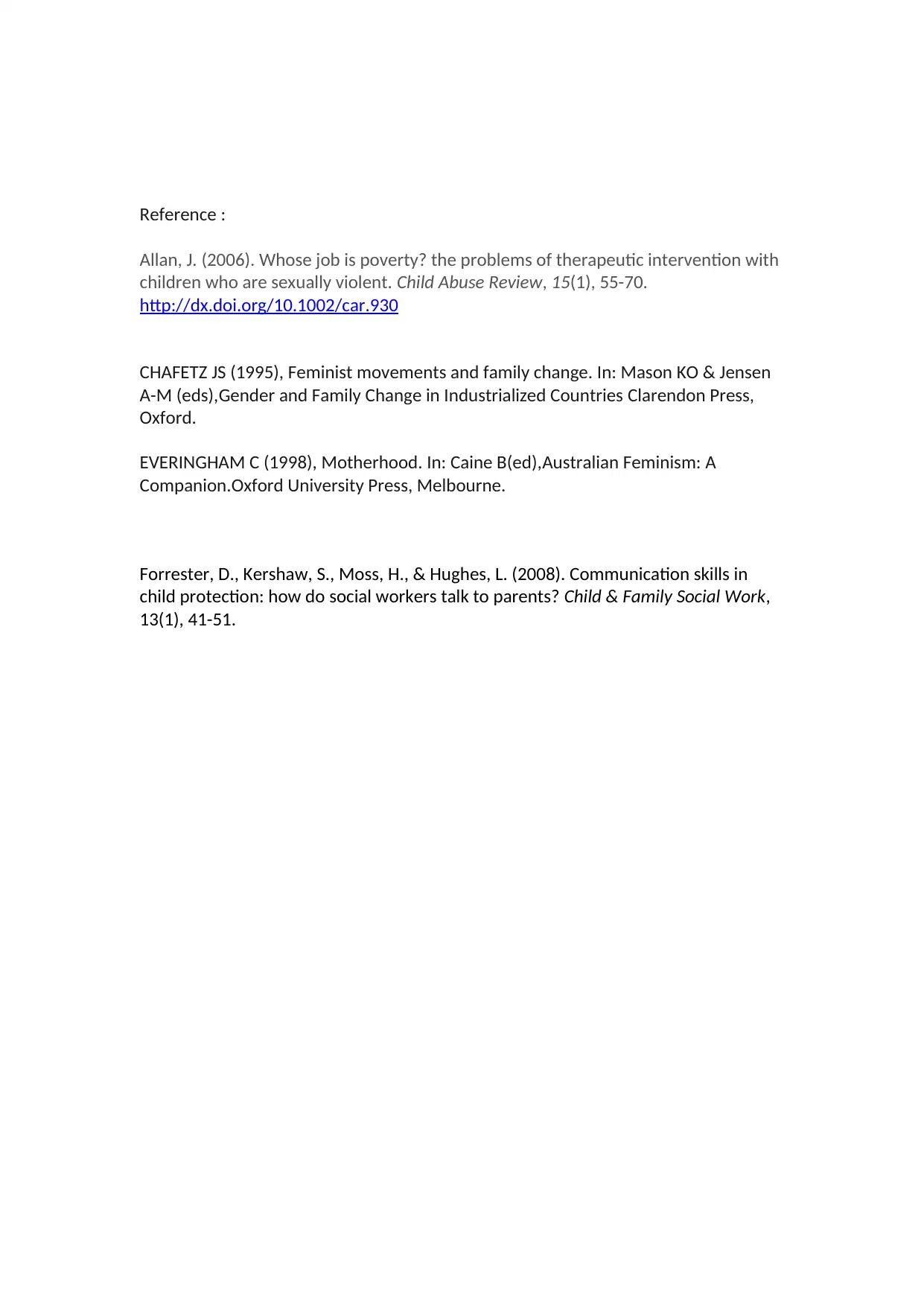
Reference :
Allan, J. (2006). Whose job is poverty? the problems of therapeutic intervention with
children who are sexually violent. Child Abuse Review, 15(1), 55-70.
http://dx.doi.org/10.1002/car.930
CHAFETZ JS (1995), Feminist movements and family change. In: Mason KO & Jensen
A-M (eds),Gender and Family Change in Industrialized Countries Clarendon Press,
Oxford.
EVERINGHAM C (1998), Motherhood. In: Caine B(ed),Australian Feminism: A
Companion.Oxford University Press, Melbourne.
Forrester, D., Kershaw, S., Moss, H., & Hughes, L. (2008). Communication skills in
child protection: how do social workers talk to parents? Child & Family Social Work,
13(1), 41-51.
Allan, J. (2006). Whose job is poverty? the problems of therapeutic intervention with
children who are sexually violent. Child Abuse Review, 15(1), 55-70.
http://dx.doi.org/10.1002/car.930
CHAFETZ JS (1995), Feminist movements and family change. In: Mason KO & Jensen
A-M (eds),Gender and Family Change in Industrialized Countries Clarendon Press,
Oxford.
EVERINGHAM C (1998), Motherhood. In: Caine B(ed),Australian Feminism: A
Companion.Oxford University Press, Melbourne.
Forrester, D., Kershaw, S., Moss, H., & Hughes, L. (2008). Communication skills in
child protection: how do social workers talk to parents? Child & Family Social Work,
13(1), 41-51.
1 out of 5
Related Documents
Your All-in-One AI-Powered Toolkit for Academic Success.
+13062052269
info@desklib.com
Available 24*7 on WhatsApp / Email
![[object Object]](/_next/static/media/star-bottom.7253800d.svg)
Unlock your academic potential
Copyright © 2020–2025 A2Z Services. All Rights Reserved. Developed and managed by ZUCOL.





